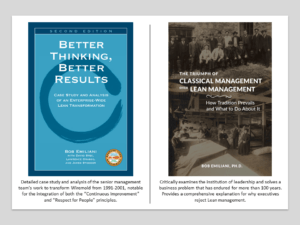Sometimes people ask me: “Do you assign books that you have written to students taking courses you teach?” The answer is no, until this past Fall semester. For the last several years the assigned reading for my graduate Lean Leadership course was The Lean Turnaround by Art Byrne and The Toyota Kaizen Continuum by John Stewart. For several years prior to that I used no book (to save students money), and other books in the early years when the course was first taught beginning in 2001. So, the answer now is yes (for just one course). I loan the books to students; they do not buy them due to an obvious conflict of interest. Learning is more important than book royalties.
I assigned two books to be read in the order of Better Thinking, Better Results (BTBR) followed by The Triumph of Classical Management Over Lean Management (TCM). My thinking was that students should first learn the great things that can be accomplished with Lean management (BTBR) and then learn the details of why Lean transformations are so rare (TCM). This order also represents the chronology of my own process of discovery and learning, beginning with how to achieve great success with Lean management (BTBR, 2003) and then figuring out why such outcomes are so uncommon (TCM, 2019).
The students liked both books very much. But, my process of discovery and learning is not the same for students. At the end of the semester, a student suggested that I should reverse the order of the assigned reading: The Triumph of Classical Management Over Lean Management should come first followed by Better Thinking, Better Results. I asked other students, and they agreed that the order should be reversed. Here’s why:
- First, understand the full nature of Classical management and its many limitations
- Learn where Lean management sprang from (i.e. the world of classical management; TCM)
- The contrast between the two is better if BTBR follows TCM
- Learn what is possible with Lean management (BTBR) despite a dizzying array of barriers (TCM)
- Finish the course with a happy ending (BTBR)
So, next semester (Spring 2020), the reading assignments will be reversed.
The dark side, yin (TCM), and the bright side, yang (BTBR), provide a complete picture of the old and new management and their associated leadership routines. The benefit of understanding both the dark side and the bright side is two-fold:
- Calmness in knowing what is going on in the highly conflicted worlds of Classical management and Lean management
- More complete knowledge results in better problem-solving and better decision-making
But more than that, this reversal aligns with a longstanding criticism that I have had with the promotion of Lean management. Namely, insufficient attention has been given to the sources and causes of executive indifference to Lean management and, especially, to Lean transformation — and the resulting struggles and failures that individuals and organizations commonly experience.
For more than 30 years, Lean management has been advanced as if the problems identified in The Triumph of Classical Management Over Lean Management did not exist. These problems existed long before Lean. They were evident 100 years ago as Lean’s antecedent, Scientific Management, faltered. Its promoters also ran into the problem of executive indifference to a better system of management and improved leadership practice.
It would have been great if a book like The Triumph of Classical Management Over Lean Management came out near the end of Scientific Management’s life cycle in the late 1930s, so that those promoting (TPS and) Lean in the 1980s could have learned from it to help others experience greater individual and organizational success. But, unfortunately, we cannot rewind the clock to the late 1930s to change the order in which discovery and learning took place. We are, therefore, forced to move forward.
I cannot loan you these books, but each one is inexpensive to buy. I am certain you will enjoy reading The Triumph of Classical Management Over Lean Management followed by Better Thinking, Better Results. I am also certain that you will find it highly beneficial to comprehend both the yin and yang, of management (versus yang only).

